By Larry S. Sterett | Contributing Editor
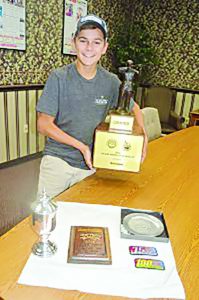
15-year-old Kelan Kinion of Middletown, MO, a sophomore at Silex High School, took the Grand American Handicap with a perfect 100 score. (Photo by Bob Simmons from the Lincoln County Journal.)
The 2018 Grand American Trapshooting event, the 119th Grand, was held Aug. 1-11 at the World Shooting & Recreation Complex (WSRC) north of Sparta, IL. (Signature sponsors were Bill and LeeAnn Martin, with 50 or so industry sponsors providing support.) Preceding the Grand was the AIM (Academics-Integrity-Marksmanship) Nationals shoot, held at the Complex on July 27-31 for youth.
The Grand actually consists of two parts—Preliminary Week from Aug. 1-5, and Grand Week Aug. 6-11, ending with the Grand American Handicap (Event #24) on Aug. 11. Some days there are single events, some days two events, and some days three events. (Most events consist of 100 single targets or 50 pair of doubles. Three events—10, 15, and 21—consist of 200 singles targets, with Event #10 being shot over two days—100 targets each day.) This year the single event days were Aug. 6—Winchester AA Class Singles, Aug. 9—ATA World Clay Target Championship, and Aug. 11— Grand American Handicap. Each year finds some new shooter(s) attending and this year there was a new group of five shooters from the United Kingdom shooting at the Sparta complex for the first time. According to Neil Phillippo, spokesman for the group, the trip took several years of planning, but it was worth the effort. They arrived at Chicago O’Hare on Monday and made it to Sparta on Wednesday just in time to compete in the first event, the Hodgdon Powder Singles.
The Brits were impressed with the size of the Grand Complex, as the largest event they had previously competed in had 12 trap fields, while the WSRC has 123 trap fields spanning three and a half miles, according to ATA Executive Director Lynn Gipson. As Phillippo stated it, “We have got nothing to compare with this … until you get here you don’t understand the scope of it [even after having seen some videos]. “We’ll be doing singles as we’re not sure of the heat, then we’ll start doing doubles and the Handicap later.”
The Scoring
It’s history now and the young man who made it probably still has a grin on his face. Saturday, August 11, 2018, saw 15-year-old Kelan Kinion, a Silex, MO, high school sophomore, shoot a perfect 100 to walk away with the Grand American Handicap trophy. He shoots as a sub-junior from the 21.5-yard line, and this was his first 100-straight ever. Congratulations Kelan! What a way to get your name in the history books, the only perfect score out of nearly 2,100 shooters in the event, only his second year of competition shooting.
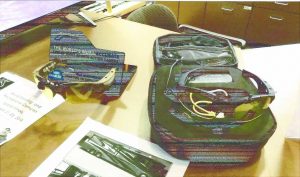
An interesting product on display at the Grand was this camera built into shooting glasses to photograph what you shoot, or attempt to shoot. Possibly more on this product to come later.
Although his father, Kurt, shoots, Kelan got into it because of a friend. “I’m kind of the first one to start shooting trap…I took a swing at it and loved it from Day One.” (Kelan shoots a Beretta 682 shotgun.) Asked if he was nervous, the young man replied, “The last few targets I just tried to focus and see the bird out of the trap house before I shot or moved my gun at all. That last bird, I thought I missed it. I lowered my gun and I saw I hit it. I almost did a jumping jack. It was crazy.” Considering there were seven 99 shooters waiting for a chance at the trophy that last bird was extremely important.
The Grand American is truly a world event for trapshooting, with shooters attending from many countries. Although Canadian shooters have often been plentiful at the Grand, shooters from Brazil have been increasing in recent years. In 2017 there were 40 Brazilians in attendance. This number doubled to 80 for 2018, prompting the ATA to play the Brazilian national anthem in their honor on Monday prior to the start of competition. (Out of an estimated 4,500 shooters at the 2018 Grand, 80 may not seem a large number—it may be the largest foreign contingent in history to attend the Grand—but consider what it takes to travel from Brazil to Illinois. Having been to Brazil, this reviewer can vouch for the fact it is a long and tiring sojourn.)
Other high scoring shooters included, Summer Gobrecht of Findlay, OH, whose 397 broken clays earned her the High All Around (HAA). Patrick Lamont of Brandon, MB, broke 986 birds to win the ATA High Over All out of 1,000 targets thrown. And Dennis Bringelson of New Raymer, CO, took the 2,600-target High Over All by breaking 2,556.
Attendance
Attendance at the 2018 Grand was up slightly—the AIM program saw a 19 percent increase from 2017 and pre-registration was up some nine percent. The weather was good—hot, but not windy–except on Tuesday, Aug. 7, when a storm front—rain, wind, etc.—moved in and forced the closing of the line and postponement of the Downrange Manufacturing Doubles Class Championship until Wednesday. (Shooting on Tuesday began at noon, and at two o’clock the lines were shut down and everyone was to seek shelter. At about 2:30 p.m. it was announced shooting would begin again and squad members began returning to their respective fields.)
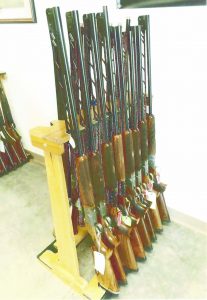
Over $53,000 worth of previously-owned shotguns on exhibit—this side only—in one of the vendor buildings behind the west line.
Although people are at the Complex to shoot, and possibly win some of the green stuff—there was $30,000 guaranteed in the Grand American Handicap—the vendors were selling everything from ice cream (homemade) to motor homes. If it is related to shooting—shotguns, shotshells, insurance, targets, belts, clothing, traps, etc.–there is probably a vendor for it on the grounds.
The west line of vendors in their air-conditioned buildings can lock up and leave whenever, and do not have to worry (much) about rain, but the east line tent vendors do not have a choice. Rain brings down the tent flaps, cardboard boxes are flattened and laid down to soak up moisture and to walk on. (One year a storm flattened some tents and blew others away, along with a few shade wagons.)
What does it take to win at the Grand? Clyde Bailey, winner of the 1959 Grand American Handicap using a third-hand Winchester Model 12, told this reviewer “a good eye, confidence, and a reliable shotgun you have confidence it will do the job if you do your part.” Several years later the GAH at Vandalia was won by a young man shooting a second hand Valmet over/under. Sparrow Young won a lot of trophies using a shotgun he designed, and another prominent shooter used a well-worn Winchester Model 37 single shot hammer gun according to the placard in the Hall of Fame Museum. Be like the little engine…think positively and practice, practice, practice.
Hall of Fame
A visit to the Hall of Fame Museum, west of the Entry Building, is worth at least an hour or more of anyone’s time. The latest addition is the shotgun used by Tom Marshall to win the 1897 and 1899 Grand American Handicaps, the last time the targets were live birds and not clay targets. (Marshall was the only person to ever win the GAH twice when live birds were used as targets. Only 25 live birds were used opposed to today’s 100 clay saucers. However, live birds—pigeons–do not necessarily fly in a straight line when released from a trap; their flight may be erratic, and it was not unknown to have one fly toward the shooter.)
Thomas A. Marshall grew up in Keithsburg, Illinois, on the Mississippi River, in Mercer County, a couple of hundred plus miles north of St. Louis. (Mercer County borders Henderson County, which has one of the oldest operating courthouses in Illinois, on the south. Henderson was where Abraham Lincoln passed through during the Black Hawk War, and also were he had a friend
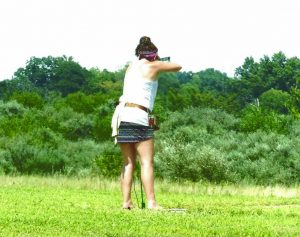
Different shooters have different stances. The house seen through a gap in the trees, and at which the shooter appears to be aiming, is several hundred yards away and on the other side of a bordering highway. She nailed the bird however.
by the name of Phelps who operated a trading post; the Phelps house still stands on the bluff overlooking the Mississippi River at the north edge of Oquawka, Illinois.) In Keithsburg, Marshall won the Mercer County Cup in 1875 at age 19. Later he became a pharmacist, served as town mayor, and owned the two telephone company. He traveled the world shooting, hunted with John Phillips Sousa, was awarded a medal by Queen Victoria in England, and was among the first 15 original inductees into the ATA Hall of Fame in 1969.
Tom’s shotgun—a 12 gauge–was manufactured by the William Cashmore Gun Co.–Annie Oakley shot a Cashmore gun—of Birmingham, England. The gun is in pristine condition not having been fired since 1922, when Marshall died two days after competing the Great Lakes Zone shoot. It has been stored in a gun closet, according to his great-grandson Tom Kester II; the gun was recently appraised at $25,000, which seems a bit low considering its history.
Tuesday evening, August 7, 2018, the 50th Annual Hall of Fame banquet was held in the Main Events building. This year there were four men inducted, one—Tom Garrigus–was a former Olympic trapshooter. (At the 1968 Games in Mexico City Tom broke 196, plus 50, to earn the silver medal, the highest award a U.S. Shooter had won since 1920.) During his shooting career he won more than two dozen awards at the Grand American, was an ATA champion in three states—Oregon, Idaho, and Montana, and he and his wife Jackie, were referees at the Atlanta Games in 1996, when Kim Rhode burst onto the Olympic scene.
Fred Nagel’s trapshooting career began when he was eight years old, and two years later in 1974 shot his first registered targets. In 1980 Fred broke his first 200 in the Clay Target Championship at the Grand, and he and his father became the first father and son to post 200s in the same Grand event. (At induction time, Fred had a total of sixteen 200s in Grand competition.)
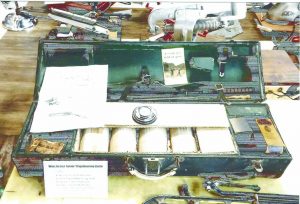
On display in the ATA Hall of Fame Museum is this Winchester Junior Trapshooting Outfit, complete with 100 miniature targets, trap, cleaning equipment, instructions, etc. but minus the single shot Model 20 single barrel .410-bore shotgun.
Gary Sherrod, of Lubbock, TX, was the ATA President in 2010, having been the Texas TA president in 1979. He made it to the 27-yard line in 1974, broke his first 100 in doubles in 1974, his first 200 in 1982, and his first 100 from 27 yards in 1996, completing his Grand Slam. (In 2016 Gary became the oldest shooter to break 100 targets from 27 yards earning him top honors in the Trap & Field Handicap.)
Pat Stacey, an Oklahoman from Frederick won his first trapshooting trophy at a 500-bird marathon shoot in Kansas, by breaking 93 out of the third 100 birds. Four years later he captured his first state title, to which he has added another dozen, plus 12 Singles, two Handicap, and 10 Doubles. (His 2009 Handicap was perfect, the first such by a resident in 55 years.)
There were fifteen Hall of Fame inductees, including three women—Lela Hall Frank, Annie Oakley, and Elizabeth (Plinky) Topperwein—when the program first started. Many of the names are familiar, others not so much. Among the many are Capt. A.H. Bogardus, W.F. (Doc) Carver, Thomas A. Marshall, Homer Clark, Fred Gilbert, Fred Kimble, Jimmy Robinson, Charles (Sparrow) Young, Vic Reinders, Herb Bush, Arnold Rieger, Punkin Flock, Fred Etchen, Dan Orlich, Rudy Etchen, Betty Ann Foxworthy, Bob Allen, D. Lee Braun, John Philip Sousa, Frank Little, Ray Stafford, Homer Clark Jr., Herb Orre, Dan Bonillas, Kay Ohye, Herb Parsons, Leo Harrison III, Nadine Ljutic, Tom Frye, Lou Ann & Robert Munson, Frank Hoppe, Richard A. (Dick) Baldwin, John Hall, Mike Jordan, Bill & LeeAnn Martin, Jacque Snellenberger, and Dieter Krieghoff.



